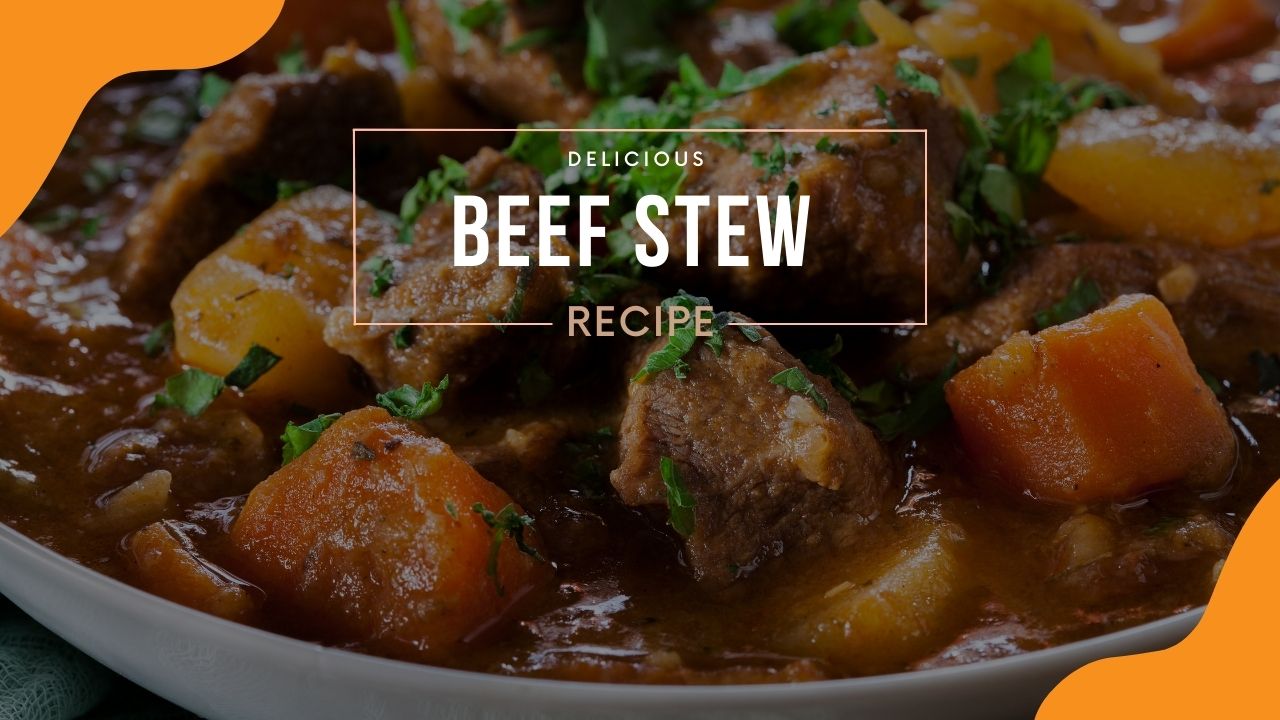Traditional Beef Stew Recipe: An Inspiring Family Favorite for Generations
The Timeless Appeal of Beef Stew
In this blog, you’ll uncover the enduring charm of classic beef stew recipes, learn the secrets of crafting the perfect pot, and discover why it remains a beloved favorite worldwide. There’s something innately comforting about a bowl of beef stew, its rich aroma filling the kitchen with the promise of warmth and satisfaction. Passed down through generations, this traditional dish is more than just a meal; it’s a culinary ritual that brings families together.
Ingredients You’ll Need for the Perfect Beef Stew
Creating a delicious beef stew starts with choosing the right ingredients. The core components include succulent beef, vibrant vegetables, and a medley of spices that meld together in a symphony of flavors. For optimal taste, stick to fresh, high-quality ingredients. Each element is key, contributing to this dish’s hearty texture and rich flavor.
Stock your pantry with essentials like carrots, potatoes, and onions, which add natural sweetness and depth. Don’t forget the beef broth or stock, which forms the stew’s base. With these ingredients, you can create a tasty meal that satisfies you.
Choosing the Right Cut of Beef
The success of your beef stew largely hinges on the cut of beef you select. Go for stricter cuts like chuck or round, which become tender and flavorful when simmered. These cuts are well-marbled, ensuring a melt-in-your-mouth texture that enhances the stew’s richness.
While premium cuts might be tempting, they perform less well in stews due to their lean composition. Instead, opt for cuts that thrive under prolonged cooking, allowing their connective tissues to break down and infuse the stew with unbeatable flavor.
The Importance of Fresh Vegetables
Fresh vegetables are the backbone of any good beef stew, providing texture, nutrition, and color. Carrots, potatoes, and celery are staples that balance sweetness and earthiness. They complement the beef and absorb the savory broth, enriching the stew with their essence.
When selecting vegetables, look for vibrant colors and firm textures. Fresh produce ensures maximum flavor and nutrient retention, making each spoonful a wholesome delight. You can also experiment with different tastes and textures by choosing seasonal vegetables, keeping the stew exciting every time.
Essential Herbs and Spices for Flavor
Herbs and spices are the soul of beef stew, adding layers of complexity and aroma. Bay leaves, thyme, and rosemary are classic choices that impart an earthy fragrance, while garlic and pepper provide a subtle kick. Don’t shy away from experimenting with spices like paprika or cumin for a unique twist.
Fresh herbs can be swapped for dried ones if needed, but remember that dried herbs pack a more concentrated punch. Use them sparingly to strike the right balance, ensuring every bite bursts with flavor without overwhelming the palate.
Step-by-Step Guide to Preparing Beef Stew
Crafting a delectable beef stew is a labor of love, requiring attention to detail at each step. Gathering all your ingredients, washing and chopping the vegetables, cutting the beef into uniform cubes, and having everything prepped and ready sets you up for a smooth cooking process.
Next, heat your pot and brown the beef. Add the aromatics to build a robust foundation of flavor. Carefully add the vegetables, ensuring each ingredient has due time to shine. Finally, allow the stew to simmer and meld into a harmonious blend.
Browning the Beef: A Crucial Step
Browning the beef is a pivotal step that should be taken. This process, known as the Maillard reaction, enhances the stew’s depth by caramelizing the meat’s exterior. Use a hot pan and sear the beef in batches to prevent overcrowding, which can cause steaming instead of browning.
A good sear locks in juices, creating a more flavorful and succulent final dish. Don’t rush this step—patience here pays dividends in taste, adding a savory richness that forms the backbone of your stew.
Building the Flavor Base with Aromatics
Aromatics like onions, garlic, and celery lay the foundation for a rich beef stew. Sauté them until golden and fragrant, allowing their flavors to develop. This step is crucial for building depth, as the caramelized bits left in the pot contribute a wealth of flavor.
Incorporating aromatics early ensures ample time to soften and meld with the other ingredients. Their savory essence permeates the stew, raising it from ordinary to extraordinary.
Adding the Vegetables: Timing is Key
When adding vegetables to your stew, timing is everything. Some vegetables, like carrots and potatoes, benefit from long cooking times and become tender and flavorful. Others, such as peas or green beans, should be added later to maintain their vibrant color and crispness.
To achieve the perfect texture, stagger the addition of vegetables based on their cooking times. This careful orchestration ensures that each component retains its integrity, contributing its distinct character to the stew.
Simmering to Perfection: Patience Pays Off
Slow simmering is the heart of a great beef stew, allowing flavors to meld and the beef to become tender. Once all ingredients are in the pot, gently reduce the heat and let the stew bubble. Cover the pot partially to regulate evaporation and concentrate flavors.
Patience is critical here—rushing this stage can produce tough meat and underdeveloped flavors. Give the stew at least two hours to reach its full potential, stirring occasionally and adjusting the seasoning as needed.
Thickening the Stew: Tips and Tricks
A thick, hearty stew is the ultimate comfort food. To achieve this, you can use a few tried-and-true methods. One popular technique is to coat the beef in flour before browning, which naturally thickens the stew as it cooks.
Alternatively, you can create a slurry with cornstarch or flour and water, stirring it into the pot towards the end of cooking. For a more rustic approach, mash a few cooked potatoes into the stew, giving it a body without added starch.
Adjusting Seasonings to Taste
Seasoning is a personal affair, and adjusting the flavors of your stew to suit your palate is essential. Taste the stew as it simmers, and tweak the salt, pepper, or herbs as needed. Remember that flavors intensify over time, so err on caution and adjust incrementally.
Consider a splash of Worcestershire sauce or a dash of vinegar to brighten flavors for added depth. A well-balanced stew tantalizes the taste buds, leaving an impression on all who enjoy it.
Serving Suggestions: What Pairs Well with Beef Stew
Beef stew is a different dish that pairs beautifully with various accompaniments. Serve it alongside crusty bread to soak up the rich broth or over a bed of creamy mashed potatoes for added comfort. A side salad of mixed greens offers a refreshing contrast, balancing the stew’s hearty nature.
Pair your stew with a robust red wine, like Merlot or Cabernet Sauvignon, for a touch of elegance. These wines complement the stew’s richness, elevating your dining experience.
Storing and Reheating Leftovers
Leftover beef stew is a gift that keeps on giving. Store it in an airtight jar in the refrigerator for up to three days, or freeze for extended storage. When reheating, do so gently on the stove to preserve the stew’s integrity.
Stew often tastes even better the next day as the flavors develop. Reheat and enjoy, savoring the harmonious blend of ingredients that make every bowl a comforting delight.
Variations on the Classic Beef Stew Recipe
Though traditional beef stew is beloved, there’s room for creativity. Experiment with different ingredients to add your personal touch. Swap beef for lamb or venison for a flavor change, or add mushrooms for earthiness.
Incorporating international spices, such as curry powder or smoked paprika, can give your stew a unique twist. The possibilities allow you to tailor the recipe to your tastes and preferences.
Making Beef Stew in a Slow Cooker
For convenience, consider preparing beef stew in a slow cooker. This method allows you to set and forget it, freeing up time for other activities. Follow the same rules for browning the beef and sautéing aromatics, then transfer everything to the slow cooker.
Cook on low for 6-8 hours, allowing the rich flavors to meld and develop. The result is a tender, flavorful stew that requires minimal effort—a perfect solution for busy days.

Beef Stew for Special Occasions
While beef stew is often associated with casual dining, it can also shine as a centerpiece for special occasions. Elevate the dish by garnishing it with healthy fresh herbs or serving it in artisanal bread bowls for a sophisticated touch.
Consider pairing the stew with fine china and elegant table settings to create a memorable dining experience. Its rich flavors and comforting nature make it a perfect option for gatherings with loved ones.
Health Benefits of Homemade Beef Stew
Homemade beef stew isn’t just delicious; it’s also nutritious. Packed with protein, vitamins, and minerals, it’s a well-rounded meal that supports overall health. Lean cuts of beef provide essential amino acids, while vegetables supply fiber and antioxidants.
Making stew from scratch allows you to control the ingredients, ensuring a wholesome meal free from additives and preservatives. It’s a nourishing choice that satisfies both the body and soul.
Common Mistakes to Avoid
Even seasoned cooks can make mistakes when preparing beef stew. Avoid common pitfalls such as using lean cuts, resulting in dry, tough meat. Overcooking vegetables is another issue, leading to mushy, unappealing textures.
Rushing the cooking process is a surefire way to compromise flavor. Instead, take your time, allowing each step to unfold naturally. Your stew will turn out perfectly every time with patience and attention to detail.
Why This Recipe is a Family Favorite
In conclusion, our traditional beef stew recipe is a cherished family favorite for good reason. Its rich flavors, tender meat, and hearty vegetables create a symphony of comfort and satisfaction. Each bowl tells a story of shared meals and cherished memories, making it more than just a dish—it’s a testament to the power of food to bring people together.
We invite you to try this timeless recipe and discover its magic. Whether enjoyed on a cozy evening or as part of a special celebration, beef stew will become an amazing addition to your culinary repertoire.
Frequently Asked Questions (FAQs)
1. What is a traditional beef stew recipe?
A traditional beef stew recipe typically includes hearty cuts of beef, a variety of vegetables like carrots and potatoes, and a rich broth that develops over a long cooking time. This classic approach creates a delicious, comforting dish that many families have enjoyed for generations.
2. How do I make an easy beef stew recipe?
For an easy beef stew recipe, simplify the ingredient list and cooking process. Use pre-cut vegetables, and opt for a one-pot method for convenience. Browning the beef, adding vegetables, and letting everything simmer together makes for a quick yet satisfying meal.
3. Can I make a beef stew recipe in a slow cooker?
Absolutely! A beef stew recipe is perfect for a slow cooker. After browning your beef and sautéing your aromatics, combine everything in the slow cooker and let it cook on low for 6-8 hours. This method allows the flavours to meld beautifully without constant monitoring.
4. What’s an easy beef stew recipe on the stove?
For an easy beef stew recipe on the stove, simply brown the beef, add your vegetables and seasonings, and cover with broth. Let it simmer for a few hours, and you’ll have a delicious stew ready quickly.
5. How do I make an old-fashioned beef stew recipe on the stovetop?
An old-fashioned beef stew recipe on the stove top involves slow cooking your ingredients in a heavy pot. Use tough cuts of meat, brown them thoroughly, and add root vegetables. The key is to let it simmer for a long period, allowing the meat to become tender and the flavours to deepen.
6. What makes the best beef stew recipe?
The best beef stew recipe balances a variety of flavours and textures. Using quality ingredients like well-marbled beef, fresh vegetables, and rich seasonings will elevate your stew. Patience during cooking ensures a deeper flavour profile as well.
7. Can I make a beef stew recipe in a pressure cooker?
Yes, a beef stew recipe can be made in a pressure cooker. This method significantly reduces cooking time while delivering tender meat and robust flavours. Brown the beef first, then add your ingredients and cooking liquid, seal the lid, and cook under pressure.
8. What’s the difference between an Irish beef stew recipe and a traditional beef stew recipe?
An Irish beef stew recipe often includes ingredients like stout beer and is typically made with lamb or beef. It may also feature root vegetables for a dense, hearty meal. While both recipes focus on the same comforting concept, the Irish version has its own unique flavor profile.
9. Is there a quick beef stew recipe I can try?
For a quick beef stew recipe, select smaller cuts of meat that cook faster, such as stew meat. Increase the heat to reduce cooking time, and use pre-cooked broth and frozen vegetables to speed things up.
10. What’s the best way to use leftovers from my beef stew recipe?
Leftovers from your beef stew recipe can be used in various ways. They can be repurposed into a pasta sauce, stuffed into pastries, or even enjoyed as a filling for tacos.
Feel free to explore these frequently asked questions to make the most of your beef stew recipes, ensuring you create the perfect dish every time!














Post Comment